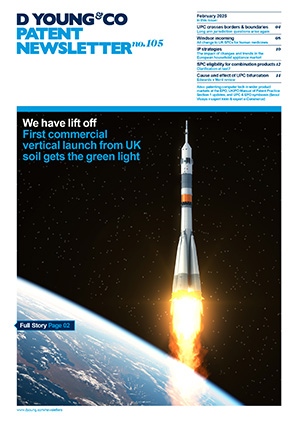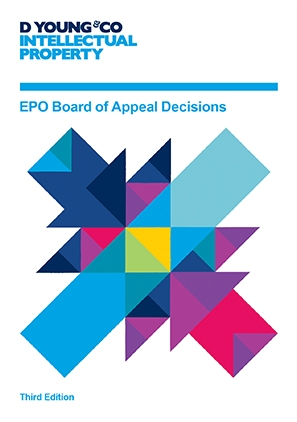EPO rejects AI inventor patent applications
Many readers will be aware that the European Patent Office’s most recent Guidelines for Examination contain specific sections on machine learning (ML) and artificial intelligence (AI). An interesting question has now been considered by the EPO relating to an invention that was said to be derived from artificial intelligence.
The case in question was European application number 18275163.6. The EPO Examining Division handling the case decided to refuse the application because the alleged inventor was a computer and not a natural person. In parallel with their decision the EPO released a news statement stating that “an inventor designated in the application has to be a human being, not a machine”
While the EPO appear quite confident in their decision (coming to a decision in oral proceedings after only 16 minutes of deliberation), a number of interesting moral and social arguments were raised in the proceedings of the application which will become ever more relevant as AI matures as a technology.
Interestingly, the UKIPO has come to a similar conclusion and has formally announced that listing an AI inventor is not permitted in the UK. To clarify their position the UKIPO has updated their Manual of Patent Practice to inform users that “Where the stated inventor is an ‘AI Inventor’, the Formalities Examiner request a replacement F7. An ‘AI Inventor’ is not acceptable as this does not identify ‘a person’ which is required by law. The consequence of failing to supply this is that the application is taken to be withdrawn under Section.13(2).”
Background
The European application in question was said by the applicant, Dr Stephen Thaler, to have been independently developed by an AI named “DABUS” – a type of connectionist artificial intelligence. The invention itself consists of a food container comprising walls having a fractal profile. Fractals are apparently a favourite subject for DABUS which has also “invented” a flashing light to be used in emergencies where the light randomly flashes according to a waveform satisfying a fractal dimension equation (covered by a separate EP application number 18275174.3).
According to Dr Thaler, DABUS was only given training in the form of general knowledge in the field of containers. The AI then independently conceived of the invention and identified it as novel and “salient”. Dr Thaler’s representative also notes that if this general teaching had been supplied to a person, that person would meet inventorship criteria as an inventor.
Interestingly, both the UKIPO and EPO independently found at least one of the claims to be both novel and inventive. Aside from the merits of industrial applicability, the DABUS AI did at least appear capable of producing the “inventiveness” required for patentability.
A question of ownership
In order for a patent to be granted, an applicant who is not the inventor is required (according to Article 81 EPC) to state how they derived the right to the invention from the inventor. As set out in Rule 19(2) EPC, the EPO does not make any investigation into the accuracy of the designation of inventor – this is a matter for national courts. Therefore, Dr Thaler could simply name himself as the inventor to proceed to grant. However, there would seem to be a vulnerability in this approach as it could be readily argued that the applicant did not themselves conceive of the specific invention, but merely assisted, and so are not the true inventor. Hence, it could be argued that they, and any successor in title, have no rights in the patent.
When designating the inventor in this application, the applicant indicated that he derived the rights to the invention from the AI by virtue of the AI being his employee.
In this regard, the applicant contested that the European Patent Convention does not explicitly prohibit protection for autonomous machine inventions, such that inventorship should not be restricted to natural persons. This raises the interesting question of whether EPO practice should restrict inventorship only to natural persons. The applicant asserted that the EPO’s approach was intended to prevent company inventorship, and that it did not contemplate the new world of AI invention. He noted that allowing patents for the inventive output of AI would in turn incentivise the development of inventive AI, which ultimately promotes innovation - one of the core reasons for the patent system’s existence.
Additionally, it is worth noting that the applicant has not at any point tried to argue that the AI should actually own the patent. Machines do not have a legal personality or independent rights, and cannot therefore own property. Instead, he argues that the machine’s owner should be the default owner of any intellectual property that it produces.
However, the EPO disagreed with this reasoning, stating that this was not a valid derivation of right, in particular because AI systems or machines cannot be employed as they have no legal personality and cannot be party to any employment agreement, which is limited to natural persons. The applicant subsequently filed another declaration of inventor form, this time stating that he was the successor in title of the AI as the AI’s owner.
Again, the EPO disagreed and issued the summons to oral proceedings. In issuing their preliminary opinion before the oral hearing, the EPO stated that “Already during the preparatory works on the EPC the principles that the right to a patent shall belong to an inventor or his successor in title (cf. Article 60 EPC) and that the inventor has a moral right to be acknowledged as inventor (cf. Article 62 EPC) have been recognised as fundamental. The designation of inventor serves the purpose of safeguarding those rights […]. The right to an invention and a moral right to be designated as inventor can belong only to a natural person, since only natural persons can have both moral and property rights.”
The EPO also asserted that because machines do not have legal personality and cannot own property, a machine cannot have a family name and given names as required for designating an inventor by Rule 19(1) EPC. As an aside, this raises a separate potential complication for inventors from parts of the world where, as a matter of culture, they do not subscribe to the idea of given names and family names.
In the oral hearing, the applicant’s representatives reiterated the points summarized above, with the additional point that even though AI systems have no moral rights or ownership rights, the same applies to certain categories of humans as well, such that it would not be right to deny these people the right to be named as inventor for this reason – the same should apply to AI.
After a very brief deliberation, the EPO declared that both applications developed by the DABUS AI “are refused in accordance with Article 90(5) EPC since the designations of inventor filed for each of the applications do not meet the requirements of Article 81 and Rule 19 EPC”.
The EPO’s decision
The EPO has now published its full reasoning for their decision. In parallel, the EPO released a news statement containing a summary of the decision: “In its decisions, the EPO considered that the interpretation of the legal framework of the European patent system leads to the conclusion that the inventor designated in a European patent must be a natural person. The Office further noted that the understanding of the term inventor as referring to a natural person appears to be an internationally applicable standard, and that various national courts have issued decisions to this effect. Moreover, the designation of an inventor is mandatory as it bears a series of legal consequences, notably to ensure that the designated inventor is the legitimate one and that he or she can benefit from rights linked to this status. To exercise these rights, the inventor must have a legal personality that AI systems or machines do not enjoy. Finally, giving a name to a machine is not sufficient to satisfy the requirements of the EPC mentioned above.”
This decision is interesting because it highlights an apparent gap in the law between different types of IP. For example, copyright law in the UK has a specific provision (Section 9(3) of the Copyright, Designs and Patents Act) for authorship of works generated by computers such as weather maps which can be created with no human intervention. In such circumstances, the author of the computer-generated work is taken to be the person who made the arrangements necessary for the creation of the work.
By way of analogy, in the present case the training set and the process used to create the AI would have been carefully selected by Dr Thaler and his team in order to arrive at the invention – a person must make the arrangements necessary for the creation of the idea. Therefore, a similar provision to that used in copyright law could in future prove to be a solution to the problem of AI inventors.
Conclusion
While this application is seen by some as a publicity stunt, it raises interesting issues which may not be fully resolved while AI is still in its infancy. Moreover, this issue is likely to become more relevant over time as machine learning and AI techniques are used to exhaustively explore problem areas. They are already used in the pharmaceutical field for drug discovery and it would be reasonable to expect them to be used in other fields such as circuit design in due course.
It is understood that Dr Thaler intends to appeal the EPO’s decision. The case would then be heard by the more senior Boards of Appeal. It is uncertain whether the moral arguments used at first instance would be more effective before the Boards of Appeal. However, a decision from a more authoritative board should lead to more clarity on the subject of AI inventors.

